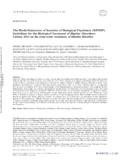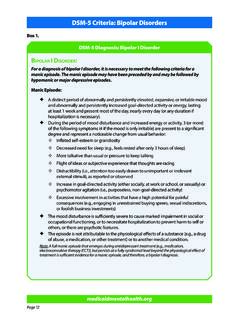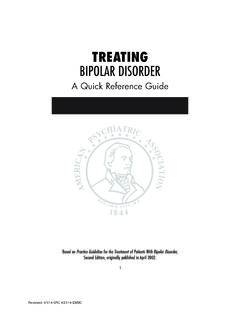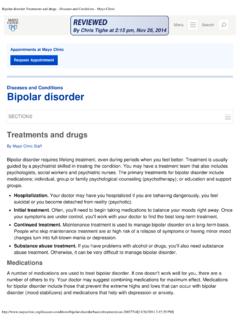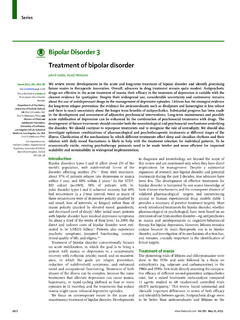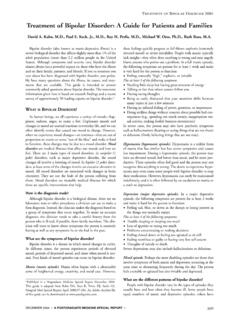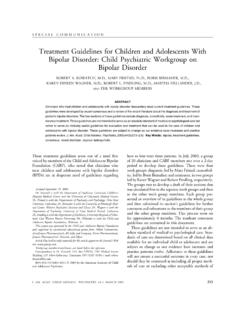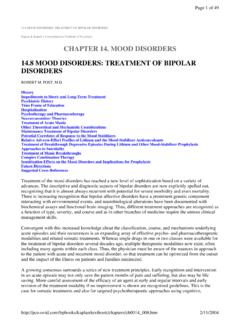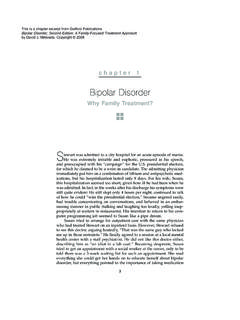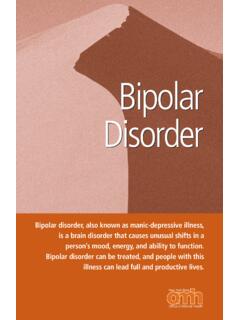Transcription of Diagnosis and Treatment of Bipolar Disorder - uermafusa.com
1 Diagnosis and Treatment of Bipolar DisorderMarissa Mariano-Mejia, PsychiatristJuly 2, 2016 Points to Cover What is the defining characteristic of Bipolar Disorder ? Bipolar I vs. Bipolar II Strategies for the Treatment of Mania, Hypomania, and Mixed Episodes Strategies for the Treatment of Bipolar DepressionWhat is Bipolar ? Newer term for Manic Depression Mood Disorder characterized by acute exacerbations of mania, hypomania, and depression. Familial illness Significant morbidity and mortalityClinical Picture Lifetime prevalence of 2-5% Age of onset: 10-20% before 10 years of age; up to 60% before age 20. Gender difference: equally common in males and females Course of illness: chronic and recurrent Risk factors: increased 8-10 fold in first-degree relatives of Bipolar adults relative to community samples. Offspring of parents with Bipolar are also at high risk to develop depression, anxiety, ADHD, and behavioral problems. Diagnostic challengeDSM-V CriteriaManic distinct period of abnormally and persistently elevated, expansive, or irritable mood, and abnormally and persistently increased goal-directed activity or energy lasting at least one week (or any duration if hospitalization is necessary)B.
2 Three or more of the following symptoms (for if the mood is only irritable) are present to a significant degree and represent a noticeable change from usual behavior:1. Inflated self-esteem or grandiosity2. Decreased need for sleep 3. More talkative than usual, or pressure to keep talking4. Flight of ideas, or subjective experience that thoughts are racing5. Distractibility, as reported or observed6. Increase in goal-directed activity (either socially, at work or school, or sexually) or psychomotor agitation ( purposeless, non-goal-directed activity)7. Excessive involvement in activities that have a high potential for painful consequences ( engaging in unrestrained buying sprees, sexual indiscretions, or foolish business investments) Impairment in social or occupational functioning, or need to hospitalize, or presence of psychotic episode is not attributable to the physiological effects of a substance ( drug of abuse, a medication, other Treatment ) or to another medical condition.
3 Mnemonic: GRAPES(+D) G: Grandiosity R: Racing thoughts A: Activity level P: Pressured speech E: Elevated mood S: Sleeping less D: DistractibilityDSM-V CriteriaDSM-V CriteriaMajor Depressive Episode or more of the following symptoms have been present during the same two week period and represent a change from previous functioning, at least one of the symptoms is either depressed mood or loss of interest / pleasure. 1. Depressed mood, as indicated by either subjective report or observations by others 2. Markedly diminished interest or pleasure in almost all activities (as indicated either by subjective accounts or observation) 3. Significant weight loss or gain, or increase or decrease in appetite. (Also, failure to make expected weight gain in children) 4. Insomnia or hypersomnia 5. Psychomotor agitation or retardation (observable by others) 6. Fatigue or loss of energy 7. Feelings of worthlessness or excessive or inappropriate guilt (which may be delusional) 8.
4 Diminished ability to think or concentrate, or indecisiveness (either by subjective account or observed by others 9. Recurrent thoughts of death, recurrent suicidal ideation with or without specific plan, or a suicide attempt. Mnemonic: SIGECAPS: Sleep, Interest, Guilt, Energy loss, Concentration, Appetite, Psychomotor agitation/retardation, Suicidality B. Symptoms cause clinically significant distress or impairment in social, occupational, or other important areas of functioning. C. The episode is not due to the physiological effects of substance or another medical HPI (identify manic or depressive episodes first) Drug use history, family/genetic history, medical conditions, medications Collateral info Family Members Screening Tools MDQ (Mood Disorder Questionnaire); score 7 and above confirmsFor Bipolar I Diagnosis one needs a manic episode hypomanic or depressive episodes For Bipolar 2 Diagnosis one needs a hypomanic episode and a depressive episode.)
5 *Mixed Episodes/Rapid CyclingDistinguishing Bipolar Depression from MDD Family history of Bipolar Disorder Earlier onset of illness Antidepressant misadventures (mood switches) Reverse neurovegetative symptoms (hypersomnia and increased appetite) History of postpartum depression Psychotic features Mixed episode presentations History of suicide attempts Mood reactivityDifferential Diagnosis Schizophrenia Schizoaffective Disorder Cyclothymic Disorder Major Depressive Disorder Substances (Methamphetemine, cocaine) Medications (Steroids, etc.) Medical Conditions (Hyperthyroidism, MS) ADHD / Borderline Personality DisorderTreatment OptionsManagement of Mania and Hypomania Assess need for hospitalization For mild to moderate manic or mixed episodes and hypomania -first line monotherapies are Lithium Valproate Second-generation antipsychotics These could also be used in various combinations ( lithium or valproate with antipsychotic) Treatment Recommendations Second-line therapy for Mania and Hypomania Other anticonvulsants, like carbamazepine and oxcarbazapine, with or without an antipsychotic Blood levels for anticonvulsants Maintenance Treatment Same medications can be continued Long-acting injectables of second-generation antipsychotics Clozapine and ECT Psychotherapy (CBT, family focus therapy, psychoeducation, interpersonal therapy)
6 Treatment Options for Bipolar Depression The three FDA-approved Acute Bipolar Depression therapies Olanzapine Fluoxitine combination Quetiapine monotherapy lithium or valproate Lurazidone as monotherapy or lithium or valproate Other Treatment options or strategies: lithium, valproate, carbamazepine, ECT, antidepressants (controversial) Antidepressants avoid in Bipolar I patients, those with mixed episodes or rapid cyclers, those with comorbid substance abuse, and should only be considered after better supported approaches prove insufficient and only in combination with a mood stabilizer FDA-Approved Medication for Maintenance LamictalFuture DirectionsStudies in the Pipeline Genetic and neuroimaging findings Immune System The role of oxidative stress Dopamine and glutamate systems Disruptions in biological rhythmsReferences Stahl, Stephen M. Stahl s Essential Pschopharmacology: Neuroscientific Basis and Practical Applications. 3rdEdition, 2008.
7 Diler MD, Rasim Somer. Early Identification of Bipolar Disorder , UPMC Synergies, 2012. Baldassaro, Claudia; Chengappa MD, Roy; and Perlis, Roy. Managing Bipolar Mania. Janicak MD, Phillip G; Esposito MS MD, Joseph. An Update on the Diagnosis and Treatment of Bipolar Disorder Parts I and II. Psychiatric Times, 2015. Nasrallah MD, Henry. Bipolar Depression Diagnosis , Confounding Factors. Current Psychiatry, 2016. Ketter MD, Terence A. Improving the Management of Bipolar Mania With Early Detection, Evidenced-based Treatments, and Patient Education. PeerView in Review, 2015. Ketter MD, Terence A. Treating Bipolar Disorder : Are Antidepressants Ever an Option? Psych Congress Network, 2015. Post-Test Questions True or False: 1. The presence of mania or hypomania is the defining characteristic of Bipolar Disorder . 2. Bipolar I Disorder distinguishes itself from Bipolar II by meeting the criteria for a full manic episode. 3. Bipolar II must meet criteria for both hypomanic and depressive episodes.
8 4. Lithium, valproate, and second-generation antipsychotics, in monotherapy or in various combinations, can be used to treat mania, hypomania, and mixed episodes. 5. There are only four FDA-approved medications for Treatment of Bipolar depression.
